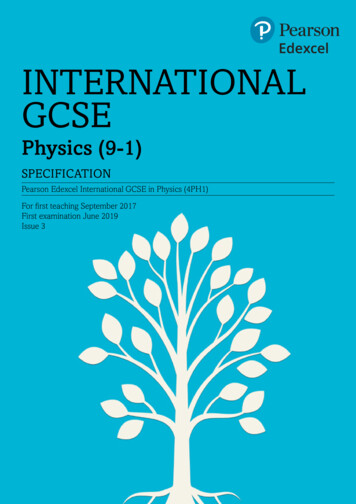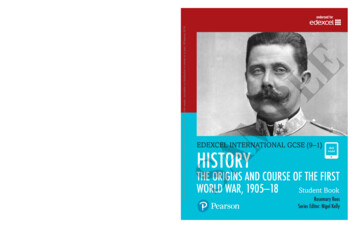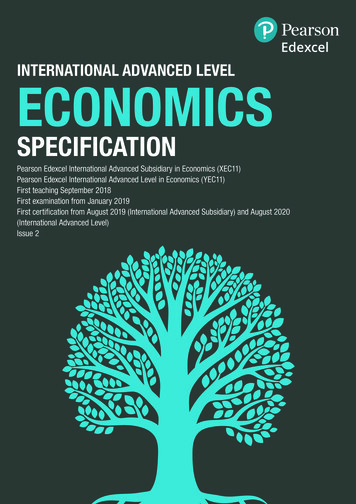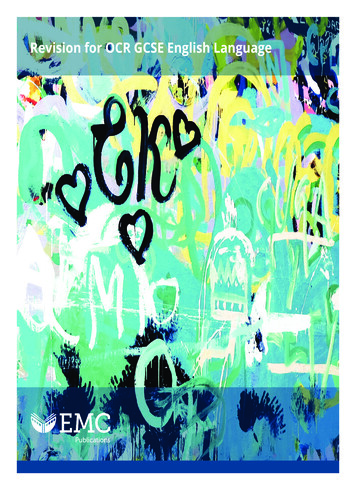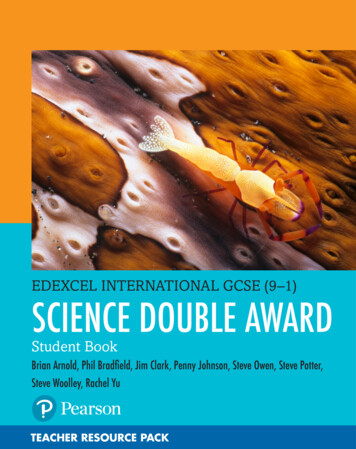
Transcription
EDEXCEL INTERNATIONAL GCSE (9 –1)SCIENCE DOUBLE AWARDStudent BookBrian Arnold, Phil Bradfield, Jim Clark, Penny Johnson, Steve Owen, Steve Potter,Steve Woolley, Rachel YuTEACHER RESOURCE PACK
Chapter 1: Life Processes1. The diagrams show an animal and a plant cell.(a) Label the structures shown on the diagrams. Pearson Education Ltd 2018. Copying permitted for purchasing institution only. This material isnot copyright free.
(b) Complete the table below to indicate whether the structures are present or absent.Structurecell membraneAnimal cellPlant cellcellulose cell ribosome(c) Complete the table listing the functions of different organelles.OrganelleFunctioncell wallcell membranecytoplasmcontains genetic materialprotein synthesisaerobic respirationchloroplastlarge vacuole Pearson Education Ltd 2018. Copying permitted for purchasing institution only. This material isnot copyright free.
2. Identify each of these specialised cell types and suggest how they are adapted for theirfunction.Name of cell: Adaptations . Name of cell: Adaptations . Name of cell: Adaptations . Name of cell: Adaptations . Name of cell: Adaptations . Pearson Education Ltd 2018. Copying permitted for purchasing institution only. This material isnot copyright free.
3. The diagram shows a section through a leaf and an artery.Leaf cross sectionArtery cross section(a) Define the terms tissue, organ and system.tissue .organ .system (b) Explain whether a leaf is a tissue, organ or system. Pearson Education Ltd 2018. Copying permitted for purchasing institution only. This material isnot copyright free.
4. Read the passage below:In 2014, at the age of 14, Hannah had a horse riding accident resulting in a broken spine anddamaged spinal cord. She has been left unable to walk and has lost all the feeling in her legs. Hermobility is now very restricted and she must rely on a wheelchair, needing support and care fromher family. There is currently no cure for people with severe spinal cord damage.Most body tissues can heal themselves when damaged, but nervous tissue cannot as nerve cells losethe ability to divide soon after birth. Scientists are trying to develop a technique that could offerhope to many people like Hannah. They think that embryonic stem cells taken from very earlyhuman embryos could be turned into nerve cells and used to heal damaged spinal cords and enablepeople to walk again. The embryos used are spare ones from fertility treatments that wouldotherwise be allowed to perish.It is difficult to make sure that these cells only make nerve cells and there is a danger that they couldturn into cancer cells. The research is expensive and, so far, has had limited success in animal trials.(a) Explain what stem cells are: (b) Use the information in the passage and your own knowledge to evaluate the use of embryonicstem cells by completing the table.BenefitsDrawbacksMy Conclusion:(c) Some types of stem cells, such as heart stem cells, can be taken from adults. These stem cells canstill divide but are already specialised.Explain why these cells may be better to use than embryonic stem cells. Pearson Education Ltd 2018. Copying permitted for purchasing institution only. This material isnot copyright free.
5. Complete the sentences about the properties of enzymes using the words in the box.denaturedactive sitecatalystsoptimumtwochemical reactionspHshapespecificsevenEnzymes are biological . They speed up without beingchanged themselves. A substrate binds to a region of the enzyme called the .Usually only one substrate will fit so enzymes are highly . All enzymes have atemperature at which they work fastest, this is called the temperature. If thetemperature becomes too hot, they stop working because they have . This meansthat the of the enzyme has changed and the substrate no longer fits. Enzymes also workbest at a particular . An enzyme such as pepsin that works in the stomach works best at a pHof approximately . An enzyme such as salivary amylase that is found in the mouth works bestat a pH of approximately .6. A student carried out an experiment into the effect of temperature on the time taken to digeststarch. The results are shown in the table.Temperature / oC010203040506012001401006040100280Time taken for starch to be completely digested / s23mean2201801401201201208080604012010026060The student thought that one of the results was an anomaly.(a) State what is meant by an anomalous result and identify the anomalous result in the table. (b) Calculate the mean times taken for the starch to be completely digested and write them in thetable. Do not include the anomalous result. Pearson Education Ltd 2018. Copying permitted for purchasing institution only. This material isnot copyright free.
(c) Plot a graph to show the effect of temperature on the mean time taken to completely digest thestarch. Pearson Education Ltd 2018. Copying permitted for purchasing institution only. This material isnot copyright free.
(d) Describe the effect of temperature on the mean time taken to digest the starch. (e) Explain the effect of temperature on the mean time taken to digest the starch. The student tested samples of the starch and amylase mixture for the presence of starch every 20 suntil no more starch was present.Suggest how the student could have tested for the presence or absence of starch. (f) Suggest why the times calculated by the student may not be accurate. Pearson Education Ltd 2018. Copying permitted for purchasing institution only. This material isnot copyright free.
7. The graph shows the effect of pH on two protease enzymes, pepsin that is made by the stomachand trypsin that is made by the pancreas.(a) State the optimal pH for enzyme A and enzyme B.Enzyme A .Enzyme B .(b) Identify each of the enzymes:Enzyme A: .Enzyme B: .(c) Biological washing powders often contain protease enzymes.Devise an experiment to test the effect of pH on the activity of biological washing powder. Pearson Education Ltd 2018. Copying permitted for purchasing institution only. This material isnot copyright free.
8. An experiment was carried out into the effect of temperature on the respiration rate ofgerminating seeds. The apparatus used is showed in the diagram.(a) Write down the balanced chemical equation for aerobic respiration below: (b)(i) Explain why the coloured liquid moves towards the seeds as oxygen is taken up. (ii) Suggest the function of the screw clip. Pearson Education Ltd 2018. Copying permitted for purchasing institution only. This material isnot copyright free.
The volume of oxygen absorbed was measured every 5 minutes for 25 minutes at a temperature of20oC. This was then repeated at 30oC.The results are shown on the graph.(c)(i) Calculate the slope of the lines of best fit at 20oC and 30oC to determine the mean rates ofrespiration. Show your working.Mean rate of respiration at 20oC . mm3 oxygen / minMean rate of respiration at 30oC . mm3 oxygen / min Pearson Education Ltd 2018. Copying permitted for purchasing institution only. This material isnot copyright free.
(ii) Explain the effect of temperature on the mean rate of respiration. (iii) Suggest how the reliability of the experiment could be improved. (iv) Suggest a suitable control experiment. (v) Explain whether the graphs suggest if the seeds were beginning to respire anaerobically at theend of the experiment. 9.(a) Complete the following equation for ATP synthesis and breakdown. Pearson Education Ltd 2018. Copying permitted for purchasing institution only. This material isnot copyright free.
(b) The ATP concentration in muscles and the respiration rate of an athlete were measured beforeand during exercise.The results are shown in the table below.Exercisebefore exerciseduring exerciseATP concentration/ mg per dm30.40.38respiration rate / cm3 oxygenper hour0.61.8Comment on the results explaining the effect of exercise on ATP concentration. 10. An experiment was carried out into the effect of temperature on the rate of diffusion ofammonia along a glass tube.Pieces of universal indicator paper were placed at 5 cm intervals along the tube.A piece of cotton wool with drops of ammonia was placed in one end of the tube and the timestaken for each piece to change colour recorded.The experiment was carried out at 15oC and 25oC.The apparatus is shown in the diagram.The results are shown in the table below.temperature/ oC15255 cm127Time taken for universal indicator paper to change colour / s10 cm15 cm20 cm25 cm30 cm25364760711321293643 Pearson Education Ltd 2018. Copying permitted for purchasing institution only. This material isnot copyright free.
(a) Plot a line graph to show the effect of temperature on the time taken for the ammonia to diffusealong the glass tubes. Join the points with straight lines.(b) Explain the effect of temperature on the time taken for the universal indicator paper to changecolour. .(c) Explain one factor that would need to be controlled. Pearson Education Ltd 2018. Copying permitted for purchasing institution only. This material isnot copyright free.
11.(a)(i) Define the terms diffusion and active transport.diffusion active transport .(ii) Complete the table, by writing yes or no, to make a comparison of diffusion and active transport.Featureparticles move down a concentration gradientparticles move against a concentration gradientalways requires living cellsalways requires membrane proteinsrequires ATPdiffusionactive transport(b) The effect of oxygen on the uptake of radioactive nitrate ions by a plant root was investigated.Two barley seedlings were each placed into solutions of radioactively labelled nitrate ions as shownin the diagram.Oxygen was bubbled through the solution of one plant. Argon was bubbled through the solution ofthe second plant (this ensures that the oxygen levels in the water are very low).The mass of radioactive nitrate taken up by the root was measured over time for both plants. Pearson Education Ltd 2018. Copying permitted for purchasing institution only. This material isnot copyright free.
The results are shown in the diagram.(i) Compare and contrast the changes in mass of nitrate taken up by the root over time with oxygenwith the changes in mass of nitrate taken up the root over time with argon. (ii) Explain whether the nitrate ions are taken up by the root by diffusion, active transport or bothprocesses. Justify your answer. (c) Use your knowledge of active transport to explain the following:(i) Why waterlogged soils cause poor crop growth. (ii) Why ploughing and aerating fields improves crop growth. Pearson Education Ltd 2018. Copying permitted for purchasing institution only. This material isnot copyright free.
Chapter 7: Ionic compoundsIons and ionic bonding1. Use the words in the box to complete the gaps below. Use each word only once.Missing words: anion, cation, charge, decreases, electrons, ion, ionic, metal, negative, non-metals,oppositely, outer, positiveIonic compounds usually contain a and a non-metal. An is an element orcompound that has lost or gained . Metals lose electrons to formions. Non-metals form negative ions by electrons. The charge ofthe metals and non-metals change because electrons have a charge. If electronsare gained the overall negative increases. If electrons are lost the negative overallcharge . A positively ion is known as a and a negative ion is knownas an . To form an bond, electrons move from a metal atom to the nonmetal atom. This produces a positive and a negative ion. The charged ionsthen attract each other. Electrons are transferred from the metals to the tocomplete the non-metals atom’s electron shell.The structure of ionic compounds2. Draw dot and cross diagrams for the following compounds:a. Aluminium oxide (Al2O3)b. Iron chloride (FeCl2)c. Potassium nitrate (KNO3) Pearson Education Ltd 2018. Copying permitted for purchasing institution only. This material is not copyright free.
3. Add the symbols for the ions formed by the following elements and compounds.Element/compoundCalciumIon mmoniumBerylliumSulfatePhosphorousNitrateIon formedIonic compounds4. Give the formula for the following ionic compounds.a. Aluminium hydroxideb. Barium sulfatec. Ammonium chlorided. Calcium carbonatee. Copper(II) chloridef. Lead(II) nitrateProperties of ionic compounds5. Look at the table below. Use the data to decide which of the compounds are ionic andwhich are not.CompoundPQRSMelting point/0C2015-87300558Boilingpoint /0C2980-675001506Electrical conductivitywhen moltenGoodPoorGoodGoodElectrical conductivitywhen in aqueous solutionGoodPoorInsolubleGoodThe ionic compound(s) are: Pearson Education Ltd 2018. Copying permitted for purchasing institution only. This material is not copyright free.
Chapter 16: Work and Power1 a State the equation that links work, energy and power.b A student pulls a box of mass 5 kg with a force of 20 N through a horizontal distance of 2.5 m.Calculate the work done by the student.c Another student transfers 60 J of energy to another box by pushing it with a force of 15 N.Calculate how far the box travels.2 a A lorry is driving at a speed of 20 m/s. The engine of the lorry provides a driving force of500 N. Calculate the work done by the lorry in 1 second.b The driver of the lorry increases the driving force to 700 N. The engine transfer 35 kJ of energyto the lorry. How far does the lorry travel?3 Calculate the kinetic energy of the following:a a cyclist on his bike with a combined mass of 85 kg travelling at a speed of 4 m/sb a runner of mass 65 kg running at a speed of 5.5 m/sc a bullet of mass 250 g travelling at a speed of 65 m/s Pearson Education Ltd 2018. Copying permitted for purchasing institution only. This material is not copyright free.
4 Calculate the gravitational potential energy of the following:a a 3 kg robot dog jumps up 0.5 mb a lift of mass of 500 kg rises 15 mc the Mars Rover, 15 m above the surface of Mars (gravitational field strength is 4 N/kg)5 A ball of mass 2.5 kg rolls from the top of a hill to the bottom and falls through a height of 5 m.Calculate the ball’s speed at the bottom of the hill. (g 10 N/kg)6 At a weightlifting competition, a weightlifter lifts a 30 kg barbell through a distance of 1.5 m.a Calculate the weight of the barbell.b Calculate the GPE of the barbell at the top of its motion.c The weightlifter takes 30 seconds to lift the barbell 10 times. Calculate the total power outputof the weightlifter. Pearson Education Ltd 2018. Copying permitted for purchasing institution only. This material is not copyright free.
Chapter 19: Natural Selection and EvolutionTextbook pages261–267Chapter overviewThis topic covers the work of Charles Darwin, evolution, natural selection and the reasons for theincrease in bacterial resistance to antibiotics.What to expectSpecification areas covered:3.38 explain Darwin’s theory of evolution by natural selection3.39 understand how resistance to antibiotics can increase in bacterial populations, and appreciatehow such an increase can lead to infections being difficult to control.Although this seems a short chapter and does not have a great deal of factual learning, the conceptsare very important. Students need to have a secure knowledge and understanding of the process ofnatural selection in order to be able to explain exam questions that may use unfamiliar situations.Homework tasks can include research on Charles Darwin and his work, answering worksheetquestions and explaining examples of the adaptations of organisms in terms of natural selection.Teaching notes Students should have studied chapters 16, 17 and 18 and have a good understanding of thenature of genetic variation.A good starting point is to introduce Charles Darwin and his work. Darwin’s observations(page 262 of textbook) could be given to students and they could then deduce the theory ofnatural selection.Evidence for evolution could be considered by students including: bringing in fossils orshowing pictures of fossils (Archaeopteryx is a good example for students to identify bothreptile and bird features) and demonstrating pictures of the peppered moth and Galapagosfinches (or tortoises).Students could be given a range of different scenarios and asked to apply the stages ofnatural selection (mutation, variation, adaptations, survival, reproduction, repeat overgenerations, increased allele frequency).A range of animals and plants with different adaptations could be presented to studentswho then identify how they survive. This could be done by placing photographs (or plantssuch as cacti) around the room and students then rotate around the room explaining theadaptations of each. The value of camouflage can be tested practically (see practicals). A tripto a zoo or botanical garden would be a good experience for students.Antibiotic resistance can be introduced by looking through newspaper articles that describeits increase. It is possible to purchase non-pathogenic bacteria that have resistance todifferent antibiotics. Students could carry out research into the spread of antibioticresistance and methods that could reduce it. A practical can be carried out by placingantibiotic discs on plates of these bacteria to identify resistance.Possible misunderstandings Some students confuse alleles and genes – this should be reinforced when considering theprocess of natural selection. Pearson Education Ltd 2018. Copying permitted for purchasing institution only. This material isnot copyright free.
Some students think that organisms are mutated deliberately or change deliberately tosurvive better. This is best illustrated by having many different coloured blocks to start withand ‘killing off’ certain colours.Differentiation For extension, students could research the work of Lamarck and explain how it compares toDarwin’s findings. They could also research epigenetics and how it affects Darwin’s work.Less-able students could produce posters or leaflets to describe Darwin’s work and / orbacterial resistance to antibiotics. A sentence sorting exercise on the stages of naturalselection would help them appreciate the order of events. Less-able students often benefitfrom seeing real-life examples and, if possible, trips to zoos and safari parks would be veryuseful – or even carrying out an Internet project on the adaptations of particular species.PracticalsPracticals listed in the textbookThere are no practicals in this chapter.Additional practicals Camouflage. Pieces of drinking straw of different colours (or dyed pasta) can be placed into atank or box of sawdust. The same number of pieces of each colour should be used (about 20or 30, depending on the size of the tank or box). Students should try to remove as manystraws as possible in 10 seconds. This is repeated until no more straws are left. A graph canbe plotted of the remaining number of straws of each colour against time. This can then beconsidered in terms of allele frequency.Bacterial resistance. Some non-pathogenic strains of bacteria can be purchased that havedifferent antibiotic resistances. They can be grown on plates with antibiotic discs and theresults demonstrated to students. Pearson Education Ltd 2018. Copying permitted for purchasing institution only. This material isnot copyright free.
Chapter 5: Chemical formulae, equations and calculations Part 1Alignment with Student Book: Pages 38-63Chapter overviewThis chapter introduces quantitative chemistry. Students will explore chemical formulae, includingbalancing equations. There will be a focus on the use of calculations including relative molecularmass and relative atomic mass. The use of experimental data will feature prominently and studentswill use a variety of techniques including reacting masses and the determination of formula bycombustion. The different types of formula will be introduced for the first time.What to expect1.25 write word equations and balanced chemical equations (including state symbols): for reactions studied in this specification for unfamiliar reactions where suitable information is provided1.26 calculate relative formula masses (including relative molecular masses) (Mr) fromrelative atomic masses (Ar)1.27 know that the mole (mol) is the unit for the amount of a substance1.28 understand how to carry out calculations involving amount of substance, relativeatomic mass (Ar) and relative formula mass (Mr)1.29 calculate reacting masses using experimental data and chemical equations1.30 calculate percentage yield1.31 understand how the formulae of simple compounds can be obtained experimentally,including metal oxides, water and salts containing water of crystallisation1.32 know what is meant by the terms empirical formula and molecular formula1.33 calculate empirical and molecular formulae from experimental data1.36 practical: know how to determine the formula of a metal oxide by combustion (e.g.magnesium oxide) or by reduction (e.g. copper(II) oxide)This chapter contains material that is much more complex. Due to the quantitative nature ofmuch of the content students will need to have relatively strong mathematical skills. Pearson Education Ltd 2018. Copying permitted for purchasing institution only. This material is not copyright free.
Balancing equations should not be new to students and so will not need much time.However, teaching how to calculate relative atomic mass and relative formula mass willneed ample time set aside. The mole has been a regularly identified topic which studentseither do not fully understand or find very boring. Though the use of the mole in thischapter is limited, it cannot be emphasised strongly enough how important it is for studentsto fully comprehend what the mole is and how it is used. As much practice should be givenas possible, either in class or for homework, using the different equations and calculations.As there is so much practical work, lesson time must be considered so as not to rush thecalculation aspect of the investigation.Teaching notesStarter ActivitiesElements and compounds states game - Students must write three lists. One for each of thethree states of matter and list as many elements or compounds they can name that occur ineach state at room temperature.The mole demonstration - Weigh out 1 mole of a variety of different elements to reinforcethat although the substances have different masses they have the same number of particlesinside (Carbon 12g, water 16g, Magnesium 24g, copper(II) carbonate 124g). Ask students ifthey recognise the numbers for the elements from anywhere? Are they on the periodictable? The mass of 1 mole is equal to the relative atomic mass.Main activities/practical workBalancing equations practice - Give students a variety of unbalanced equations. This can bedifferentiated very easily with some students given more complex examples.The change in mass when magnesium burns demonstration or practical - Students weighsome magnesium ribbon then burn it in air. They reweigh the new compound formed anduse the result to determine the formula of magnesium oxide. See activity three on page 48of the textbook.Determining relative atomic mass practical - Students measure the volume of hydrogen gasproduced when magnesium ribbon reacts with hydrochloric acid to determine the relativeatomic mass of magnesium.Finding the formula of hydrated copper(II) sulfate practical - Students weigh some hydratedcopper(II) sulfate and then heat it to remove the water. They reweigh the copper(II) sulfateto find the water of crystallisation. Mole calculations are then used to find the formula. Seepage 53 of the textbook. Pearson Education Ltd 2018. Copying permitted for purchasing institution only. This material is not copyright free.
Finding the formula of copper oxide using methane practical or demonstration - Copper(II)oxide is reduced using methane gas which is passed over the oxide as it is heated. This is acomplicated practical and so may be better as a demonstration with some students. Byweighing the Copper(II) oxide and then the copper produced the formula of copper(II) oxidecan be calculated. See activity 4 on page 49 of the textbook.Determining the formula of water demonstration- See page 51 of the textbook.HomeworkThe questions in the book on page 60-63 provide enough challenge to be set for a numberof homework sessions. The homework sheet in the TRP offers additional questions.Possible misunderstandingsAs students may struggle with the concept of the mole, try to use the analogy of a dozen. Adozen apples and a dozen bananas do not have the same mass but there is the samenumber of each fruit. Students may confuse the different formulae they need to use so caremust be taken to ensure they know when to use each.When completing practical work remind students to weigh their r
EDEXCEL INTERNATIONAL GCSE (9–1) SCIENCE DOUBLE AWARD Student Book Brian Arnold, Phil Bradf
